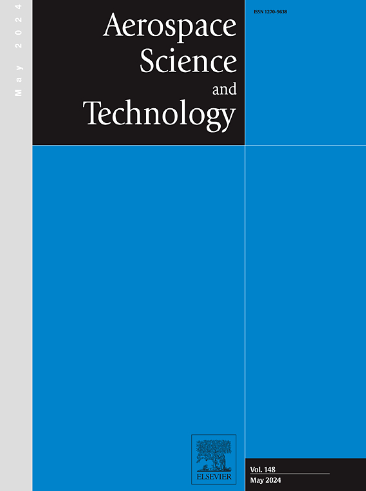不同横向周期作动器诱导流动特性的实验研究
IF 5.8
1区 工程技术
Q1 ENGINEERING, AEROSPACE
引用次数: 0
摘要
带气源的吹流控制技术可以提高飞机的性能,而横向射流技术可以减少供气需求,降低发动机或压气机的压力。为了研究横向射流的特性,设计了连续横向射流(CTJ)和离散横向射流(DTJ)两种方案进行了实验研究。采用微控制器技术,针对径向运动的圆形自由射流,研制了两种形式的横向射流执行器。采用粒子图像测速(PIV)技术对这两种横向射流作动器的流场进行了实验研究。通过对比不同横向射流作动器下的流场特性,分析了两种作动器外流场结构差异背后的机理。结果表明,引起射流射流偏转的主要原因是邻近射流的涡吸效应,而引起CTJ偏转的主要原因是喷嘴处机械装置引入的展向速度。这导致DTJ在截面上表现出自相似的无因次速度分布,而CTJ则没有。在时间平均流场中,观察到DTJ的最大流速和覆盖范围都大于CTJ。CTJ的单射流偏转后,在不同的流动方向上形成反旋涡,使其流速覆盖沿流向逐渐缩小。固有正交分解(POD)分析表明,与DTJ相比,CTJ的前两个主导模态在Z方向上由于额外的展向速度而表现出更大的挠度。风洞试验证实,在相同流量下,横向射流比稳定射流的升力系数提高了70%。本文章由计算机程序翻译,如有差异,请以英文原文为准。
Experimental investigation of different transverse periodic actuator-induced flow characteristics
Blowing flow control technology with air sources can enhance aircraft performance, while transverse jet technology may reduce air supply requirements and lower the pressure needed from engines or compressors. To investigate the characteristics of transverse jets, experimental studies were carried out by designing two schemes: Continuous Transverse Jet (CTJ) and Discrete Transverse Jet (DTJ). Using microcontroller technology, two forms of transverse jet actuators were developed for circular free jets that move radially. Particle Image Velocimetry (PIV) technology was used to experimentally study the flow fields of these two transverse jet actuators. By comparing the flow field characteristics under different transverse jet actuators, the mechanisms behind the structural differences in the external flow fields of the two types of actuators are analyzed. The results indicate that the main reason for the deflection of DTJ is the vortex suction effect from adjacent jets, while the deflection of CTJ is primarily due to the spanwise velocity introduced by the mechanical device at the nozzle. This leads to DTJ exhibiting self-similar, dimensionless velocity distribution across sections, while CTJ does not. In the time-averaged flow field, it is observed that the maximum flow velocity and coverage range of DTJ are larger than those of CTJ. The single jet of CTJ, after deflection, forms counter-rotating vortices at different flow directions, causing its flow velocity coverage to gradually shrink in the streamwise direction. The analysis from Proper Orthogonal Decomposition (POD) indicates that, compared to DTJ, the first two dominant modes of CTJ show a greater degree of deflection in the Z direction due to the additional spanwise velocity. The wind tunnel test verifies that, at the same flow rate, the traverse jet increases lift coefficient by up to 70 % compared to the steady jet.
求助全文
通过发布文献求助,成功后即可免费获取论文全文。
去求助
来源期刊

Aerospace Science and Technology
工程技术-工程:宇航
CiteScore
10.30
自引率
28.60%
发文量
654
审稿时长
54 days
期刊介绍:
Aerospace Science and Technology publishes articles of outstanding scientific quality. Each article is reviewed by two referees. The journal welcomes papers from a wide range of countries. This journal publishes original papers, review articles and short communications related to all fields of aerospace research, fundamental and applied, potential applications of which are clearly related to:
• The design and the manufacture of aircraft, helicopters, missiles, launchers and satellites
• The control of their environment
• The study of various systems they are involved in, as supports or as targets.
Authors are invited to submit papers on new advances in the following topics to aerospace applications:
• Fluid dynamics
• Energetics and propulsion
• Materials and structures
• Flight mechanics
• Navigation, guidance and control
• Acoustics
• Optics
• Electromagnetism and radar
• Signal and image processing
• Information processing
• Data fusion
• Decision aid
• Human behaviour
• Robotics and intelligent systems
• Complex system engineering.
Etc.
 求助内容:
求助内容: 应助结果提醒方式:
应助结果提醒方式:


